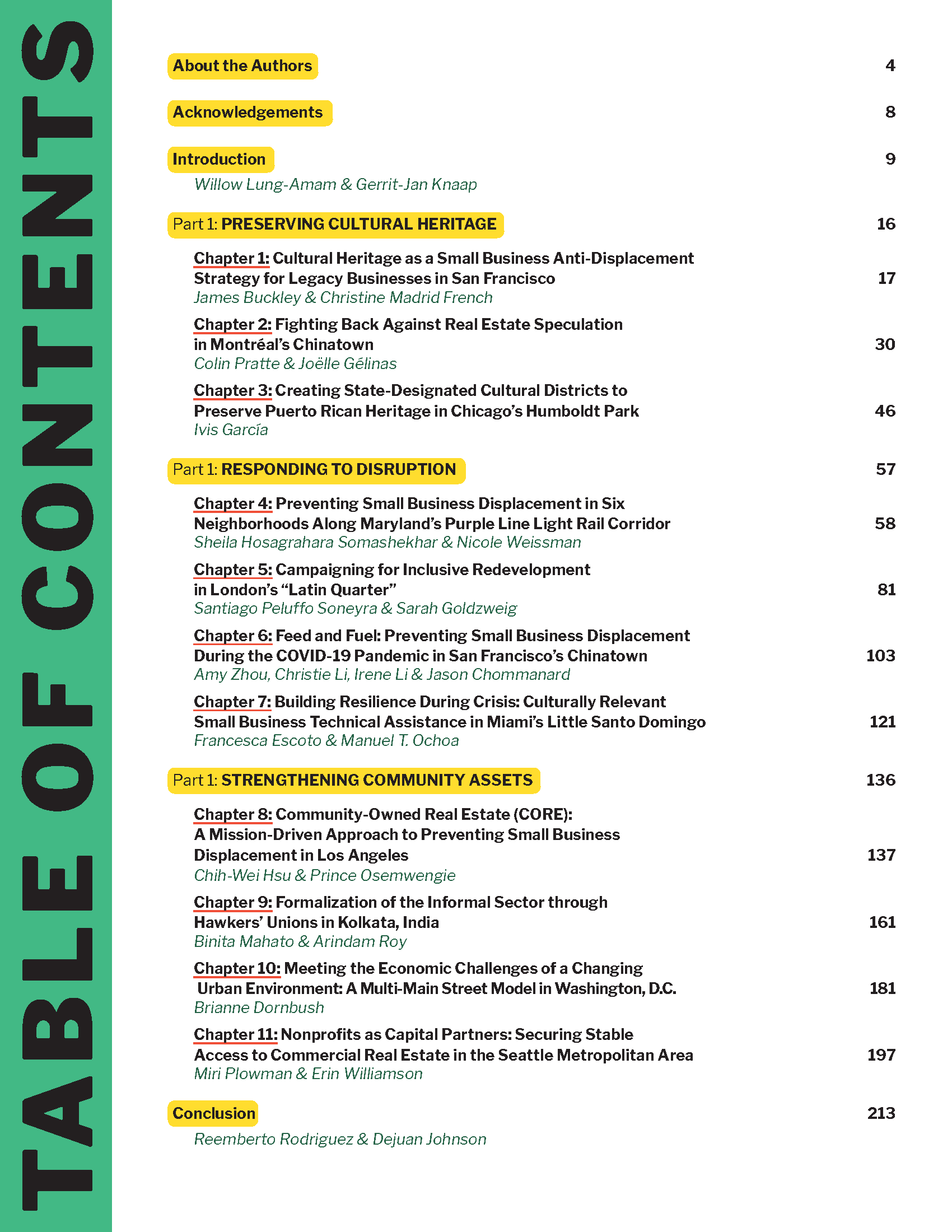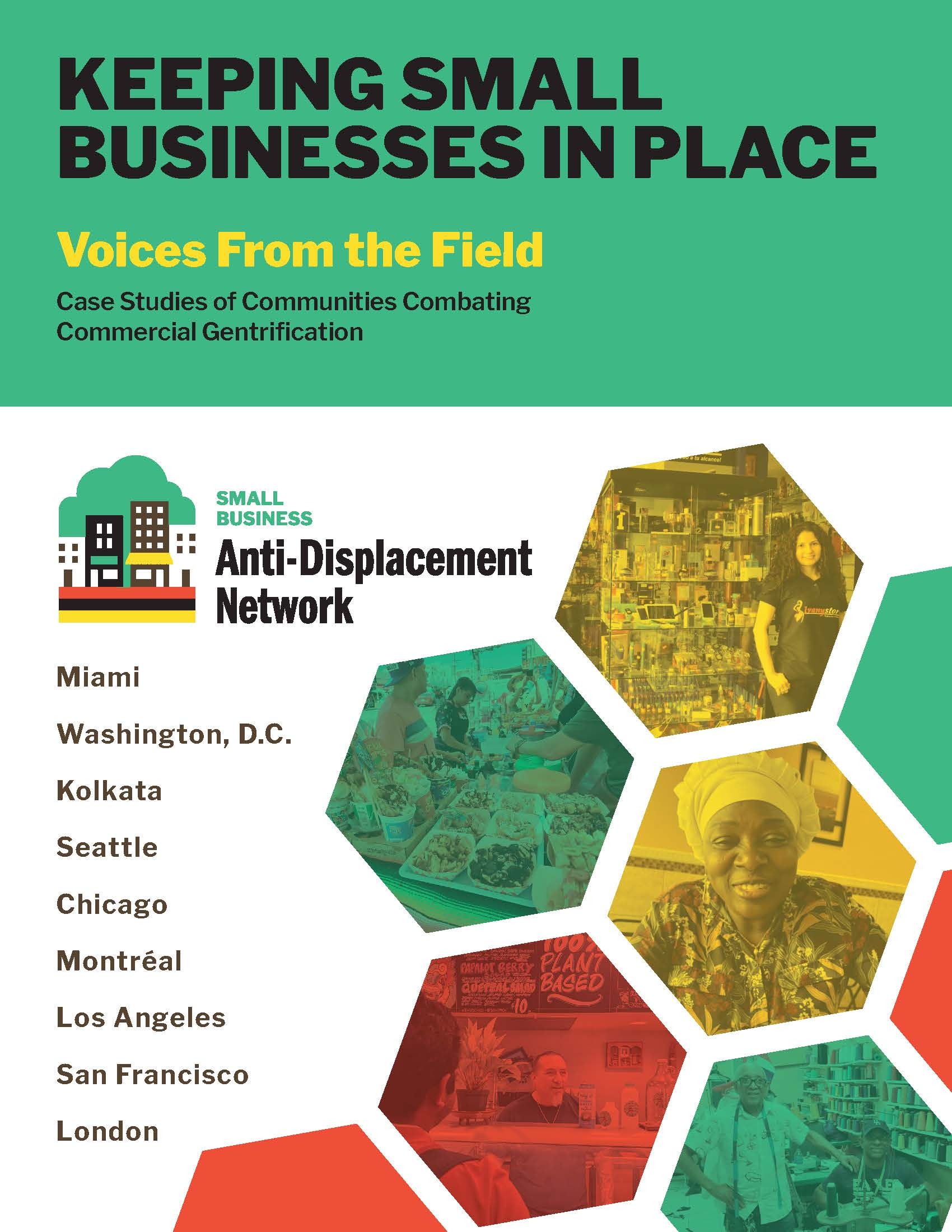2023 Case Studies Report & Film
There are critical gaps in research about what small business anti-displacement strategies are effective. In 2022, we put out our first call for case studies on the topic, and in 2023, we published our first set of case studies in Keeping Small Businesses In Place: Voices From the Field. In this report, authors from community-based organizations and academic institutions outline solutions such as community property ownership, culturally relevant technical assistance, Main Street models, new types of small business loan financing, unionization, construction disruption assistance, and cultural heritage preservation.
Our film We’re Still Here features site visits to three of these case study communities. In summer 2023, our leadership, staff, select members, and filmmakers visited Miami’s Little Santo Domingo, Chicago’s Puerto Rico Town, and the Los Angeles neighborhoods of Boyle Heights and East LA. Miami, Chicago, and Los Angeles. We talked with small business owners and learned about how The Allapattah Collaborative (Miami), the Puerto Rican Cultural Center (Chicago), and Inclusive Action for the City (Los Angeles) were fighting displacement.
Report: Keeping Small Businesses in Place

Case Study Awardees
Case study authors met with and learned from other case study teams, received support from SBAN experts, and presented their work to the network and other stakeholders at the 2022 and 2023 SBAN conferences. View the closed call for case studies to learn more about the process.
The Allapattah Collaborative CDC works to prevent the displacement of the historically Dominican neighborhood of Allapattah in the city of Miami. Its signature program, Small Business Resiliency Cohort (SBRC), is designed to ensure that businesses are able to survive a crisis as well as thrive and own their storefronts. The case study will focus on the effectiveness of the program’s interventions (business training, financial controls, digital inclusion) in keeping businesses open, increasing their profits, and preparing them for real estate ownership.
Binita Mahato, Auburn University, Kolkata, India
The informal sector runs most of the economy in India. It includes a diverse set of migrant-dominated unregulated economic activities, such as hawking and vending in public spaces. Several city-led movements have been displacing and evacuating informal hawkers and vendors from the public spaces of major metropolitan areas of India, including Kolkata, by deeming these activities a nuisance and illegal. In reaction, hawkers’ unions have been helping to formalize the informal sector and prevent informal hawkers from being displaced. This study presents the case of the Hawker Sangram Committee (HSC), the largest and most powerful federation of hawkers’ unions in Kolkata, and one of its many member unions, the Dharmatala Street Hawker Union (DSHU). It seeks to understand how unionization can act as an anti-displacement strategy for informal workers at macro and micro levels.
Chinatown Community Development Center, San Francisco
This case study focuses on the third iteration of Feed + Fuel Chinatown, a program that provided meals and meal vouchers to Extremely Low-Income families living in San Francisco’s Chinatown Single Room Occupancy (SRO) buildings. San Francisco is one of the most expensive cities in the United States, and the pressure of displacement is great. In addition to affordable housing, low-income families rely on local jobs and businesses with affordable goods and services that meet their needs. Feed + Fuel Chinatown provided these families with hot, prepared, culturally appropriate meals from local Chinatown restaurants. It supported local restaurants, kept residents employed, and reduced residents’ use of communal kitchens during COVID-19. The program created a circular infrastructure that both supported local merchants and working class, often monolingual, residents of Chinatown.
District Bridges, Washington, D.C.
District Bridges pioneered the first multi-Main Street in the country, which uses a holistic and relational approach to economic development and small business technical assistance. The organization develops trusted relationships with their business owners and listens to their unique challenges and goals. This high-touch approach is critical to the equitable and inclusive development of D.C. neighborhoods. This case study examines how, in neighborhoods experiencing rapid gentrification, these Main Street programs serve as a frontline defense for legacy businesses by helping them reposition and stabilize to become more competitive in a rapidly changing community. Additionally, because the Main Street model is community-based and community-driven, the study will show how these programs create opportunities for residents to have a voice in neighborhood development.
Inclusive Action for the City, Los Angeles
Inclusive Action for the City’s case study highlights the Community Owned Real Estate (CORE) program, which seeks to preserve locally-owned small businesses by acquiring and removing commercial properties from the speculative market, stabilizing rents, and offering tenants pathways to property ownership. CORE properties are leased to locally-owned small businesses and community-serving nonprofits at below-market rates with capped rent increases. CORE was established in 2019 from a partnership between Inclusive Action for the City, Little Tokyo Service Center, and East LA Community Corporation. The goal of the case study is to understand CORE’s current and potential impact on the community and to identify the tools needed (e.g. financial resources, partner management structure, partnerships, tenant stakeholder structure, and local policies) to sustain and scale CORE into a replicable strategy that community-based organizations can adopt in other neighborhoods.
Institut de Recherche et d’Informations Socioéconomiques, Montreal, Canada
Located near the central business district, Montreal’s Chinatown is subject to significant land speculation. The rising value of land and buildings poses a threat to the neighborhood’s small businesses and residents, whose stability depends on affordable rents and taxes. Since its founding at the turn of the 20th century, Montreal’s Chinatown has grown because of family-owned businesses. These businesses were at one time the only means of employment for members of the Chinese community because of discriminatory and racist public policies. In recent years, to help preserve its small businesses, the community has mobilized to demand zoning changes to limit building height and to obtain heritage status for Montreal Chinatown. The purpose of this case study is to document the processes of community mobilization and how this led to changes in the neighborhood.
Latin Elephant, London Metro (Borough of Southwark)
The neighborhood of Elephant and Castle in the Borough of Southwark is one of the fastest gentrifying areas in London, where many Black, Brown, Latin American and other racialized and migrant groups have been the target of commercial eviction. This case study will document two campaigns led by the UK-based charity, Latin Elephant, to retain migrant and ethnic businesses amidst gentrification. The study will highlight two successful interventions: community campaigning and “putting race in the agenda” within the planning process. Drawing on Latin Elephant’s eight years of advocacy to inform and secure changes in planning policies at local and regional levels, the case study will highlight anti-displacement strategies that other organizations who work with migrant and ethnic independent traders at risk of displacement can employ.
Puerto Rican Cultural Center, Chicago
The Puerto Rican Cultural Center was essential to creating an Illinois state bill that allows for the designation of cultural districts across the state. This designation is critical to slowing commercial gentrification in the Humboldt Park area, where most Puerto Ricans live. This case study will review the behind-the-scenes work to pass the bill, using archival documentation of the SB1833 process, including meetings and discussions. The study will also interview key figures involved in creating or reviewing the legislation to address the following: (1) how the legislation came into being, (2) barriers encountered and overcome, (3) what the legislation tries to accomplish and how, and (4) future steps and mechanisms for implementation (e.g., allocated funding, phasing, data that should be collected, etc.). The study will provide other communities with information on how to develop and find the political will to pass similar legislation.
Purple Line Corridor Coalition, Washington, D.C. Metro (Maryland)
The Purple Line Corridor Coalition (PLCC) case study will showcase small business anti-displacement efforts along a light rail transit line currently under construction in the Maryland suburbs of Washington, D.C. The PLCC, housed at the University of Maryland’s National Center for Smart Growth, is a collaborative that connects the expertise, influence, and resources of community-based partners, public agencies, and others to drive equitable outcomes for the people and businesses near the Purple Line. PLCC focuses on six commercial districts along the line where the majority of small business owners and patrons are immigrant, Black, or Latinx and where displacement risk is the greatest. Key tools deployed include: technical assistance and lending; strong commercial districts; construction disruption grants; and dialogue and collaboration for impact. The case study also explores the need for new solutions to pressing challenges, such as real estate and redevelopment pressures. It will demonstrate the power and potential of strategic collaboration to ensure existing small businesses can reap the benefits of large-scale infrastructure investments, rather than being displaced by them.
San Francisco Heritage & University of Oregon Historic Preservation Program, San Francisco
San Francisco Heritage, a preservation advocacy organization, along with faculty from the University of Oregon College of Design, will explore cross-disciplinary approaches to helping marginalized communities preserve their cultural activities amidst extreme property market pressure. The case study will focus on two programs in San Francisco that are incorporating intangible aspects of cultural practice as well as traditional brick-and-mortar designation to reduce the risk of displacement: cultural heritage districts and legacy business programs. The case study team will interview key participants, including business owners, public officials, and community leaders, to detail San Francisco’s cultural heritage strategy and illustrate these programs with examples.
Ventures, Seattle
Over the past three years, Ventures has piloted three small business anti-displacement strategies: acting as primary leaseholder, zero percent interest commercial lease loans, and pre-approval/capital access letters. The organization’s strategies are paired with unlimited business coaching, training, business incubation opportunities, and a small business loan program. Using a client-led, asset-based framework, this case study will combine data collected through Ventures’ outcome-tracking database and robust surveys with site visits and entrepreneur focus groups to gather small business stories and provide insight into the strategies’ efficacy and impact. The insight provided by entrepreneurs who lease commercial space will help Ventures solidify its anti-displacement strategy into a formal capital access program.


